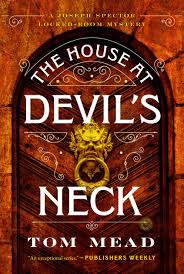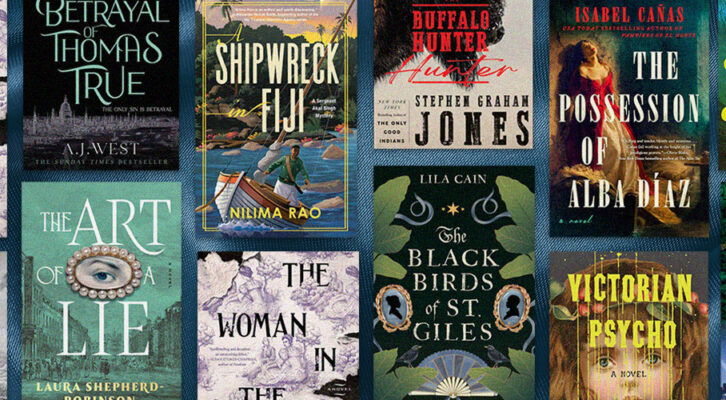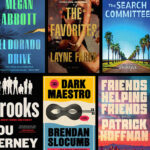As a reader, I find the most satisfying whodunits to be the ones which take place in a “closed circle.” Typically, this scenario presents the reader with a limited pool of suspects, often isolated in a single location for the duration of the plot. Popular backdrops include the snowbound ancestral home (a setting I used in my novel Cabaret Macabre), the luxury river cruise (Agatha Christie’s Death on the Nile), or the tiny island, separated from the mainland by a narrow causeway (as appears in my latest novel, The House at Devil’s Neck).
I think what makes this particular plot framework so appealing is that it enables the reader to play along—to keep track of the clues and try to beat the sleuth (and author) at their own game. As a dedicated aficionado of both the closed circle and the more specialised locked-room mystery (the two are often confused, which is understandable!), it’s been a great pleasure sifting through my collection for the purposes of this list. I hope you’ll agree with me that these are some of the most fiendish, original, and outright enjoyable closed circle whodunits on the market.
- The False Inspector Dew, Peter Lovesey (1982)
An utterly brilliant standalone mystery from a genre legend, The False Inspector Dew takes place aboard the RMS Mauretania, over a decade after the transatlantic capture of Dr. H.H. Crippen. Walter Baranov is a hapless dentist plotting the murder of his wife and determined to learn from the mistakes made by Crippen. But a series of comic misunderstandings culminates in Walter assuming the identity of none other than Inspector Walter Dew, the man who arrested Crippen. And when a murder occurs mid-voyage, this “Inspector Dew” is quickly enlisted to catch the killer. Here, the concept of the closed circle refers not only to the ship, but to the false identity: can Walter crack the case without being caught in his own elaborate deception?
- Death at the President’s Lodging, Michael Innes (1937)
Conceptually, this is perhaps the simplest “closed circle” imaginable: a fictional college of an Oxbridge university, sealed in by locked gates. But as events unfold, the situation becomes staggeringly complex: the dean is shot dead one night, and it seems only a handful of college fellows within those locked gates could be responsible. One of the very best Golden Age mystery debuts, Michael Innes writes so amusingly about the quirks of academic life, and Inspector Appleby is an engaging sleuth—but don’t be fooled! The plot is a deft and highly ingenious construction—it’s all a question of who had the key?
- Nine—And Death Makes Ten, Carter Dickson (1940)
Carter Dickson (pseudonym of John Dickson Carr, master of the locked-room mystery and one of my all-time favourite authors) presents a fascinating variant on the “murder at sea” trope. Here we have a handful of passengers (nine, in fact) on a ship crossing the Atlantic—this time, though, a murder on board seems to be the least of their problems. Their lives are in constant danger as the ship moves slowly through the perilous enemy submarine zone…
- The Invisible Circle, Paul Halter (1996)
An island mystery courtesy of another locked-room master. A motley group of seven Golden Age archetypes find themselves isolated at the castle home of the eccentric Gerry Pearson, where they have been invited—he gleefully informs them—to witness his murder. So far, so irresistible! Mystery lovers like me are in for a real treat with this one, as the single wooden bridge connecting the castle to the mainland becomes impassable, and then the murders begin…
- Green for Danger, Christianna Brand (1944)
A wartime puzzler from the pen of an unsung queen of mystery. Set in a British country hospital and featuring skulduggery among the stiff-upper-lipped doctors and nurses, the “closed circle” I’m thinking of here is actually an operating theatre, mid-surgery. To say more would constitute spoilers, but if you haven’t read this one yet, go for it. Brand kicks things off in wonderfully audacious fashion as a postman delivers a handful of letters to the hospital. We are introduced to each recipient and then informed that one amongst them is a murderer. Establishing the parameters of the closed circle in such explicit terms should make it easier for the reader to work out whodunit—but that would reckon without the plotting mastery of a genius to rival Agatha Christie.
- The Siamese Twin Mystery, Ellery Queen (1933)
One of the most brilliant early Ellery Queen novels, here the closed circle is horrifyingly literal. Ellery and his father are obliged to seek shelter at Arrow Head, a mountaintop house surrounded on all sides by dense forest. As the region is ravaged by wildfires, closing in on the house from all sides, a murder takes place. This dramatically raises the stakes: can Ellery crack the case and make it out of the inferno alive?
- Evil Under the Sun, Agatha Christie (1941)
When it comes to closed circle mysteries, nobody does it better than Agatha Christie. Evil Under the Sun is one of the most satisfying and flawless examples of the trope. Super-sleuth Hercule Poirot is taking a restful holiday at the Jolly Roger Hotel on Smugglers’ Island, off the coast of Devon. The setting is very closely based on the real-life Burgh Island, which is well worth a visit if you’re ever in that part of the world. Retired actress and full-time diva Arlena Marshall meets a violent demise while sunbathing at the secluded Pixy Cove, casting suspicion on hotel staff and holidaymakers alike.
- The Last of Sheila, Stephen Sondheim & Anthony Perkins (dir. Herbert Ross) (1973)
Something of a curveball here: a cult classic movie, and a mystery masterpiece into the bargain. There’s nothing quite like a murder game among cynical showbiz phonies, and that just happens to be the premise of this superb whodunit. With a cast to die for (James Mason, James Coburn, etc.) and a plot based on various real-life scavenger hunts contrived by Sondheim and Perkins, not to mention copious twists, disguises, bloodshed, and malicious humour, the real crime is the fact that this movie isn’t more widely celebrated in the mystery fiction world. Oh, and word to the wise: pay attention to the title. The answer might be simpler than you think…
- The Decagon House Murders, Yukito Ayatsuji (1987)
This is a mystery lover’s mystery novel. The whole plot is in dialogue with Agatha Christie and sees a university “mystery society” venture out to Tsunojima Island, scene of a brutal massacre six months earlier. Each member of the society uses a codename borrowed from a real-life author—for instance, “Ellery” (Queen), “Carr” (John Dickson), “Agatha”—but this novel is much more than mere surface-level pastiche. It’s the novel credited with re-invigorating the Japanese honkaku genre and boasts a twist so startling that I still haven’t quite recovered.
Honourable Mentions:
Before I get to my pick for number one, here are a couple of honourable mentions: first is Murder on the Orient Express, a novel which I’m sure needs no introduction. My only reason for excluding it from my top ten is that I didn’t want to overload my list with Agatha Christie. The book is brilliant, and as closed circles go, they don’t come much more formidable than a snowbound train en route across Europe!
And my other honourable mention is a short story by a legend who also appears elsewhere in my list: Peter Lovesey. The originality of the premise sets this one apart. The story is “The Problem of Stateroom 10,” and it takes place on the most infamous ill-fated vessel of them all, the Titanic. Our protagonist is none other than Jacques Futrelle, a superb author of mysteries who wrote such gloriously cunning puzzles as “The Problem of Cell 13.” Futrelle was a casualty of the Titanic, and here Lovesey imagines one last hurrah for the great man as he tries to solve a murder during the sinking. The “closed circle” here is not only one of space (the ship itself) but also time: the reader knows Futrelle’s fate is sealed—but can he unravel the mystery before it’s too late?
- And Then There Were None, Agatha Christie (1939)
And then there was one… of course I had to pick this book because it’s one of the greatest detective novels of all time, but also because it effectively codified the “closed circle” trope, with its band of victims assembled on an island under false pretences, before being picked off one by one. If by some miracle you haven’t yet read it, I envy you! You have the pleasure of discovering it still to come. It’s impossible to overestimate the scope of this novel’s influence—it really does live up to the hype, even all these years later. And if it teaches us nothing else, it’s to think twice before venturing out to a lonely island with a group of strangers…
***


















